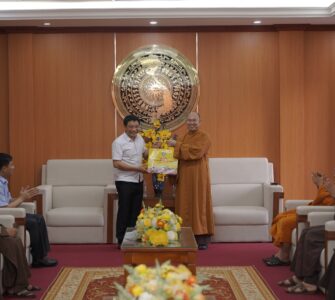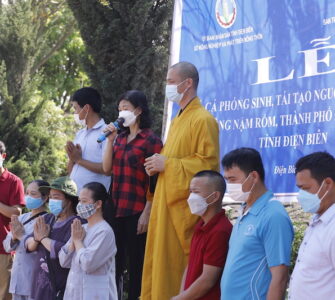Nhiều nhà lãnh đạo tôn giáo Nga đã tuyên bố rằng xác ướp của một vị Lạt ma Phật giáo đã đi lại trong đêm quanh một bảo tàng. Họ cho rằng xác ướp này thực sự đã làm điều đó vì hòa bình thế giới.
![Khambo Lama Itigilov moves - 4 - The Siberian Times.jpg These are the pictures which allegedly prove that a 164 year old Buddhist lama - who died in the lotus position - went walkabout inside his palace. The exceptionally preserved remains of Lama Dashi-Dorzho Itigilov - the revered Buddhist leader in Russia before and after the Bolshevik Revolution - are normally kept in a glass sarcophagus located on the second floor of his 'palace' near Ulan-Ude in Siberia. But now local religious leaders claim the CCTV footage shows the lama "moving" on 9 and 10 October, in what they say might be a call for world peace. Some Buddhists believe that the lama, who died in 1927 and was buried in the lotus position before his remains were exhumed with almost no decay, remains alive or hibernates in a nirvana-like state. Lama Damba Ayusheev, current head of the Buddhist Traditional Sangha, hit back at claims from doubters that one of the fuzzy pictures likely shows a security guard possibly wearing military fatigues, carrying two bags and wearing shoes. "One image shows a grainy figure in the foreground, while a second, a day later, shows a similar figure close to or on a sofa," reported The Siberian Times --- http://siberiantimes.com/other/others/news/n0769-does-this-picture-prove-164-year-old-buddhist-lama-dashi-dorzho-itigilov-has-moved/ "This is not a joke, that's for sure," posted Ayusheev, from the Republic of Buryatia, a Buddhist region of Russia. "I see a figure of a man on the shot, as you do, and I know precisely there could not be anyone in the Palace of Khambo Lama Itigilov at this time. " The first sighting was at 8.05pm and no-one had access to the lama's chamber at this time, he insisted. "The lama is in five or six metres down the hall on his throne, and this place [where the man stands] is at the front door." A second picture apparently showing lama Itiligov was on the move again, this time by the sofa. The images are poor quality and he has not released full footage but said the image was triggered by movement in the room. "There is no video, only a flash from the body on the shot," he said. "I was taken aback by this image, though somewhere in the depths of the mind I imagined such a possibility, but I still was not ready to this," said Ayusheev. A spokesman for the Buddhist Traditional Sangha of Russia, Tubden Baldanov, agree that Lama Itigelov had moved and added: "The fact that he appeared in camouflage ... We do not know. "Maybe it's some kind of sign? Maybe he says something? Perhaps, that the international organisations should work on peace?" Born in 1852, lama Itiligov was prominent in the spiritual life of tsarist Russia immediately before the Bolshevik Revolution. He took part in the Tercentenary celebrations of the House of Romanov in 1913, and and opened the Datsan Gunzechoinei, the first Buddhist temple in St Petersburg. Tsar Nicholas II invested with the Order of St. Stanislas 1917 shortly before his abdication. The famous lama died in 1927, the year after warning Buddhist monks to leave the Soviet Union because they would be overwhelmed by 'Red teaching'. His final request was to buried in the lotus position, in which he had died. When his remains were examined in 1955 and again in 1973 the monks were astonished to note no signs of decay. They kept their knowledge hidden from the Soviet authorities. In September 2002, Itigilov's body was exhumed once more in the presence of the leaders of the Buddhist Traditional Sangha of Russia. It was closely examined by monks as well as by scientists and pathologists. The remains were found to be 'in the condition of someone who had died 36 hours ago', extraordinarily well preserved and without signs of decay. Muscles and inner tissue, soft joints and skin remained intact, according to accounts of the observations. Some have claimed that the lama was preserved in salt. Others say he is in a state of hibernation, nirvana-like, and is in fact still alive.](http://phapbao.org/wp-content/uploads/2016/10/20-H01.jpg)
Những bức ảnh được cho là một vị Lạt ma Phật giáo – người đã viên tịch – di chuyển bên trong cung điện (bảo tàng) của mình. (Ảnh: The Siberian Times)
Sau khi ngồi yên lặng trong 89 năm, di hài của Lạt ma Dashi-Dorzho Itigilov – thường được lưu giữ trong một lồng kính ở Nga – được cho là đã di chuyển xung quanh một bảo tàng trên kênh CCTV.
Theo các nhà lãnh đạo tôn giáo địa phương, xác ướp vị Lạt ma đã thay đổi vị trí trong hai đêm chủ nhật và đêm thứ hai, tức ngày 9 và 10/10/2016.
![Khambo Lama Itigilov moves - 5 - The Siberian Times.jpg These are the pictures which allegedly prove that a 164 year old Buddhist lama - who died in the lotus position - went walkabout inside his palace. The exceptionally preserved remains of Lama Dashi-Dorzho Itigilov - the revered Buddhist leader in Russia before and after the Bolshevik Revolution - are normally kept in a glass sarcophagus located on the second floor of his 'palace' near Ulan-Ude in Siberia. But now local religious leaders claim the CCTV footage shows the lama "moving" on 9 and 10 October, in what they say might be a call for world peace. Some Buddhists believe that the lama, who died in 1927 and was buried in the lotus position before his remains were exhumed with almost no decay, remains alive or hibernates in a nirvana-like state. Lama Damba Ayusheev, current head of the Buddhist Traditional Sangha, hit back at claims from doubters that one of the fuzzy pictures likely shows a security guard possibly wearing military fatigues, carrying two bags and wearing shoes. "One image shows a grainy figure in the foreground, while a second, a day later, shows a similar figure close to or on a sofa," reported The Siberian Times --- http://siberiantimes.com/other/others/news/n0769-does-this-picture-prove-164-year-old-buddhist-lama-dashi-dorzho-itigilov-has-moved/ "This is not a joke, that's for sure," posted Ayusheev, from the Republic of Buryatia, a Buddhist region of Russia. "I see a figure of a man on the shot, as you do, and I know precisely there could not be anyone in the Palace of Khambo Lama Itigilov at this time. " The first sighting was at 8.05pm and no-one had access to the lama's chamber at this time, he insisted. "The lama is in five or six metres down the hall on his throne, and this place [where the man stands] is at the front door." A second picture apparently showing lama Itiligov was on the move again, this time by the sofa. The images are poor quality and he has not released full footage but said the image was triggered by movement in the room. "There is no video, only a flash from the body on the shot," he said. "I was taken aback by this image, though somewhere in the depths of the mind I imagined such a possibility, but I still was not ready to this," said Ayusheev. A spokesman for the Buddhist Traditional Sangha of Russia, Tubden Baldanov, agree that Lama Itigelov had moved and added: "The fact that he appeared in camouflage ... We do not know. "Maybe it's some kind of sign? Maybe he says something? Perhaps, that the international organisations should work on peace?" Born in 1852, lama Itiligov was prominent in the spiritual life of tsarist Russia immediately before the Bolshevik Revolution. He took part in the Tercentenary celebrations of the House of Romanov in 1913, and and opened the Datsan Gunzechoinei, the first Buddhist temple in St Petersburg. Tsar Nicholas II invested with the Order of St. Stanislas 1917 shortly before his abdication. The famous lama died in 1927, the year after warning Buddhist monks to leave the Soviet Union because they would be overwhelmed by 'Red teaching'. His final request was to buried in the lotus position, in which he had died. When his remains were examined in 1955 and again in 1973 the monks were astonished to note no signs of decay. They kept their knowledge hidden from the Soviet authorities. In September 2002, Itigilov's body was exhumed once more in the presence of the leaders of the Buddhist Traditional Sangha of Russia. It was closely examined by monks as well as by scientists and pathologists. The remains were found to be 'in the condition of someone who had died 36 hours ago', extraordinarily well preserved and without signs of decay. Muscles and inner tissue, soft joints and skin remained intact, according to accounts of the observations. Some have claimed that the lama was preserved in salt. Others say he is in a state of hibernation, nirvana-like, and is in fact still alive.](http://phapbao.org/wp-content/uploads/2016/10/20-H02.jpg)
Các chuyên gia cho rằng xác ướp Lạt ma Dorzho Itigilov đã di chuyển trong hai đêm chủ nhật và thứ hai, tức ngày 9 và 10/10/2016. (Ảnh: The Siberian Times)
Tuy nhiên, nhiều người nghi ngờ về tuyên bố này, họ cho rằng những bức ảnh công bố trên CCTV trông giống như “một nhân viên bảo vệ có khả năng mặc đồng phục quân đội, xách 2 túi xách và đeo giày”.
Lạt ma Damba Ayusheev, người đứng đầu hiện nay của Tăng đoàn Truyền thống Phật giáo, đã phản bác lại những ý kiến trên, ông cho rằng các bức ảnh “không phải là trò đùa”.

Xác ướp của Lạt Ma Dashi-Dorzho Itigilov thường được lưu giữ trong một lồng kính. (Ảnh: The Siberian Times)
Phát biểu với Siberian Times, Lạt ma Damba nói: “Một bức ảnh cho thấy những điểm nổi sần ở cận cảnh, trong khi bức ảnh thứ hai, chụp một ngày sau đó, lại cho thấy những điểm tương tự ở gần hoặc ở trên ghế sofa”.
![Khambo Lama Itigilov moves - 1 - The Siberian Times.jpg These are the pictures which allegedly prove that a 164 year old Buddhist lama - who died in the lotus position - went walkabout inside his palace. The exceptionally preserved remains of Lama Dashi-Dorzho Itigilov - the revered Buddhist leader in Russia before and after the Bolshevik Revolution - are normally kept in a glass sarcophagus located on the second floor of his 'palace' near Ulan-Ude in Siberia. But now local religious leaders claim the CCTV footage shows the lama "moving" on 9 and 10 October, in what they say might be a call for world peace. Some Buddhists believe that the lama, who died in 1927 and was buried in the lotus position before his remains were exhumed with almost no decay, remains alive or hibernates in a nirvana-like state. Lama Damba Ayusheev, current head of the Buddhist Traditional Sangha, hit back at claims from doubters that one of the fuzzy pictures likely shows a security guard possibly wearing military fatigues, carrying two bags and wearing shoes. "One image shows a grainy figure in the foreground, while a second, a day later, shows a similar figure close to or on a sofa," reported The Siberian Times --- http://siberiantimes.com/other/others/news/n0769-does-this-picture-prove-164-year-old-buddhist-lama-dashi-dorzho-itigilov-has-moved/ "This is not a joke, that's for sure," posted Ayusheev, from the Republic of Buryatia, a Buddhist region of Russia. "I see a figure of a man on the shot, as you do, and I know precisely there could not be anyone in the Palace of Khambo Lama Itigilov at this time. " The first sighting was at 8.05pm and no-one had access to the lama's chamber at this time, he insisted. "The lama is in five or six metres down the hall on his throne, and this place [where the man stands] is at the front door." A second picture apparently showing lama Itiligov was on the move again, this time by the sofa. The images are poor quality and he has not released full footage but said the image was triggered by movement in the room. "There is no video, only a flash from the body on the shot," he said. "I was taken aback by this image, though somewhere in the depths of the mind I imagined such a possibility, but I still was not ready to this," said Ayusheev. A spokesman for the Buddhist Traditional Sangha of Russia, Tubden Baldanov, agree that Lama Itigelov had moved and added: "The fact that he appeared in camouflage ... We do not know. "Maybe it's some kind of sign? Maybe he says something? Perhaps, that the international organisations should work on peace?" Born in 1852, lama Itiligov was prominent in the spiritual life of tsarist Russia immediately before the Bolshevik Revolution. He took part in the Tercentenary celebrations of the House of Romanov in 1913, and and opened the Datsan Gunzechoinei, the first Buddhist temple in St Petersburg. Tsar Nicholas II invested with the Order of St. Stanislas 1917 shortly before his abdication. The famous lama died in 1927, the year after warning Buddhist monks to leave the Soviet Union because they would be overwhelmed by 'Red teaching'. His final request was to buried in the lotus position, in which he had died. When his remains were examined in 1955 and again in 1973 the monks were astonished to note no signs of decay. They kept their knowledge hidden from the Soviet authorities. In September 2002, Itigilov's body was exhumed once more in the presence of the leaders of the Buddhist Traditional Sangha of Russia. It was closely examined by monks as well as by scientists and pathologists. The remains were found to be 'in the condition of someone who had died 36 hours ago', extraordinarily well preserved and without signs of decay. Muscles and inner tissue, soft joints and skin remained intact, according to accounts of the observations. Some have claimed that the lama was preserved in salt. Others say he is in a state of hibernation, nirvana-like, and is in fact still alive.](http://phapbao.org/wp-content/uploads/2016/10/20-H04.jpg)
Nhiều tín đồ Phật giáo tin rằng vị Lạt ma, người đã viên tịch năm 1927 và được táng trong tư thế tọa thiền trước khi di hài của ông được khai quật. (Ảnh: The Siberian Times)
“Đây không phải là một trò đùa, nó chắc chắn là sự thật. Tôi thấy hình ảnh một người đàn ông trong bức hình, như bạn thấy, và tôi biết đích xác rằng không thể có bất cứ ai trong Cung điện Khambo Lạt ma Itigilove vào thời điểm đó”.
“Xác ướp vị Lạt ma nằm cách 5 hoặc 6m phía dưới sảnh từ chỗ ngồi của ngài, và vị trí này [nơi lưu giữ xác ướp] là cửa chính”.
Dân Nguyễn (Dịch từ Metro)
Theo Pháp bảo



























